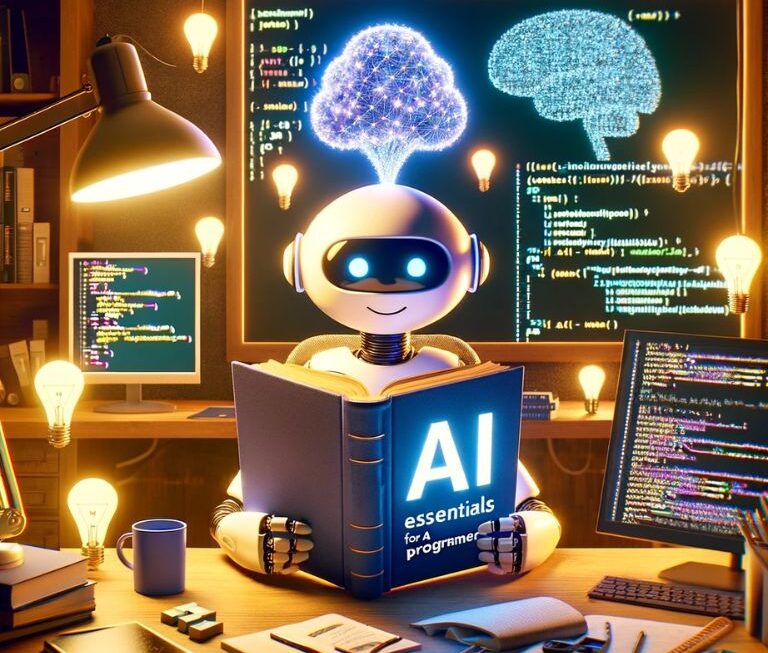Generative AI is a transformative area in artificial intelligence, enabling machines to generate new content by learning from existing data. This guide introduces beginners to the exciting world of generative AI models, covering everything from basic concepts to creating your first AI-generated project. Whether you’re a hobbyist, student, or aspiring AI professional, understanding generative AI is crucial in today’s tech-driven world.
What is Generative AI?
Generative AI involves AI algorithms capable of creating new content, such as text, images, and code, based on learned data patterns. This technology is behind various applications, from chatbots to deepfakes. It’s a field that combines creativity with technical prowess, offering endless possibilities for innovation.
Why Learn Generative AI?
- Innovation in Various Fields: Generative AI is revolutionizing creativity and problem-solving in numerous domains, from art to engineering.
- Career Opportunities: The growing AI field is constantly seeking skilled professionals, making it a lucrative career path.
- Personal Growth: Learning AI combines technical skills with creative thinking, offering a fulfilling experience. It’s a journey that challenges both your analytical and creative abilities.
Understanding the Basics
Before diving into the practical applications of generative AI, it’s essential to understand its foundational concepts. This section will help you grasp the basic principles that underpin generative AI, setting the stage for more advanced learning.
Key Concepts in Generative AI
- Neural Networks: Algorithms mimicking the human brain to process information. They are the backbone of most AI systems.
- Machine Learning: Machines using data to learn and make decisions. It’s a broad field that includes various techniques and methodologies.
- Deep Learning: A machine learning subset using layered neural networks. It’s particularly effective for complex tasks like image and speech recognition.
Types of Generative AI Models
- Generative Adversarial Networks (GANs): Two neural networks compete to improve output, often used in image generation.
- Variational Autoencoders (VAEs): Used for generating complex data like images, they work by compressing data into a smaller form and then reconstructing it.
- Transformers: Effective in understanding and generating human language, transformers have been behind breakthroughs like GPT-3.
Setting Up Your Environment
To embark on your journey with generative AI, selecting the right tools and platforms is crucial. This section will guide you through some of the most effective and user-friendly options available, ensuring you have a solid foundation for your AI projects.
Choosing the Right Tools and Platforms
The tools and platforms you choose can significantly impact your learning curve and the success of your projects. Here’s a look at some key options:
Programming Languages
- Python: Widely regarded as the most popular language for AI and machine learning. Its simplicity and readability make it ideal for beginners. Python also boasts a rich ecosystem of libraries and frameworks specifically designed for AI, such as NumPy for numerical processing and Pandas for data manipulation.
AI Frameworks
- TensorFlow: Developed by Google, TensorFlow is a comprehensive, open-source library for machine learning and deep learning. It’s known for its flexibility and extensive community support, making it a popular choice for both research and production.
- PyTorch: Created by Facebook’s AI Research lab, PyTorch has gained popularity for its ease of use and dynamic computation graph, which allows for more flexibility in building complex models. It’s particularly favored in academia and research for its intuitive interface and Pythonic design.
Online Platforms
- Google Colab: A free, cloud-based platform that provides a Jupyter notebook environment. Google Colab is ideal for those who don’t have access to high-end hardware, as it offers free GPU and TPU support, making it easier to train large models.
- Kaggle: Known for its machine learning competitions, Kaggle also provides a collaborative environment with free access to datasets and GPU. It’s a great platform for learning, experimenting, and engaging with a vibrant community of data scientists and AI enthusiasts.
Integrated Development Environments (IDEs)
- Jupyter Notebook: An open-source web application that allows you to create and share documents containing live code, equations, visualizations, and narrative text. It’s great for exploratory work and tutorials.
- Visual Studio Code: A free, lightweight but powerful source code editor that runs on your desktop. It has strong support for Python and Jupyter Notebooks, along with a vast array of extensions for other programming needs.
Additional Tools
- GitHub: Essential for version control and collaboration. It’s a repository hosting service that houses a vast majority of open-source projects, making it an invaluable resource for code sharing and collaboration.
- Docker: Useful for creating containers for your AI applications, ensuring consistency across various development and deployment environments.
Tips for Choosing the Right Tools

- Assess Your Level: If you’re a beginner, start with user-friendly tools like Python and Google Colab.
- Consider Your Project Needs: For complex projects, tools like TensorFlow or PyTorch offer advanced capabilities
- Community and Support: Opt for tools with a strong community and good documentation, as they provide valuable learning resources and troubleshooting support.
By selecting the right combination of programming languages, frameworks, platforms, and additional tools, you can create a robust environment tailored to your generative AI journey. Remember, the best tools are those that suit your specific needs and help you achieve your learning and project goals effectively.
Installation and Setup
After choosing your tools and platforms, the next step is to install and configure them. This process is crucial for a smooth and efficient workflow in your generative AI projects.
Installing Python
- Download Python:
- Visit the official Python website.
- Download the latest version of Python for your operating system (Windows, macOS, or Linux/UNIX).
- Install Python:
- Run the installer and follow the prompts. Make sure to check the box that says “Add Python to PATH” before the installation.
- After installation, verify the installation by opening your command line (cmd or terminal) and typing
python --version. You should see the Python version number.
Setting Up TensorFlow or PyTorch
- TensorFlow:
- Open your command line interface.
- Install TensorFlow by running
pip install tensorflow.This command installs the latest version of TensorFlow. - To verify the installation, run a simple TensorFlow program or execute
import tensorflow as tfin a Python shell.
- PyTorch:
- Visit the PyTorch official website and use the installation guide widget.
- Select your preferences (OS, package manager, Python version, CUDA version if you have a GPU).
- Run the provided installation command in your command line, for example,
pip install torch torchvision.
Using Google Colab
- Google Colab:
- Simply visit Google Colab.
- Sign in with your Google account.
- You can start a new notebook via the ‘New Notebook’ option.
- Google Colab comes with most libraries (including TensorFlow and PyTorch) pre-installed, so you can start coding right away.
Getting Started with Kaggle
- Kaggle:
- Create an account or sign in at Kaggle.
- Explore datasets, notebooks, and competitions.
- You can write and execute code in Kaggle Notebooks, which are similar to Google Colab notebooks.
Setting Up an IDE (Jupyter Notebook or Visual Studio Code)
- Jupyter Notebook:
- Install Jupyter Notebook by running
pip install notebookin your command line. - Launch Jupyter Notebook by typing
jupyter notebookin your command line. - Your browser will open with the Jupyter Notebook interface.
- Install Jupyter Notebook by running
- Visual Studio Code:
- Download and install Visual Studio Code from the official website.
- Open Visual Studio Code and install the Python extension for Visual Studio Code.
- You can also install the Jupyter extension to work with Jupyter Notebooks directly in Visual Studio Code.
Additional Tools
- GitHub:
- Create a GitHub account at GitHub.
- Optionally, install Git from git-scm.com for version control on your local machine.
- Learn the basics of Git for version control and collaboration.
- Docker (Optional for containerization):
- Download Docker Desktop from the official Docker website.
- Follow the installation guide for your operating system.
- Verify the installation by running
docker --versionin your command line.
Tips for Setup
- Check Compatibility: Ensure that your operating system and hardware are compatible with the tools you’re installing.
- Follow Official Documentation: For detailed installation steps, always refer to the official documentation of each tool.
- Explore Tutorials: Many online tutorials can guide you through the installation and initial setup process.
By following these steps, you will have a well-equipped environment to start exploring and creating with generative AI. Remember, the setup process is a learning experience in itself, familiarizing you with the tools you’ll be using extensively.
Your First Generative AI Project
Embarking on your first generative AI project is an exciting step into the world of artificial intelligence. This section will guide you through choosing a project, setting it up, and seeing it through to completion.
Choosing a Simple Project
For your first project, it’s advisable to start with something simple yet engaging. A text generation project, such as creating a chatbot or generating poetry, can be a great starting point. These projects don’t require extensive datasets and can be accomplished with the tools and knowledge you’ve already acquired.
Project Idea: Simple Text Generator
- Objective: Create a program that generates text based on a given input dataset.
- Tools: Python, TensorFlow or PyTorch, and a text dataset (like a collection of poems or song lyrics).
Step-by-Step Guide
Step 1: Setting Up Your Python Environment
- Install Python: If you haven’t already, install Python from python.org. Choose the version suitable for your operating system.
- Choose an IDE: Install an Integrated Development Environment (IDE) like PyCharm, Visual Studio Code, or simply use Jupyter Notebooks for writing your Python code. Jupyter is particularly friendly for beginners and for running small chunks of code interactively.
- Install Required Libraries: You’ll need specific libraries for a text generation project, such as TensorFlow or PyTorch for building the neural network, and Pandas or NumPy for data manipulation. Install these using pip (Python’s package installer):
pip install tensorflow numpy pandas Step 2: Gathering and Preprocessing Data
- Find a Dataset: Choose a text dataset relevant to your project. For beginners, a dataset like a collection of poems, quotes, or tweets works well. Websites like Kaggle have numerous datasets available.
- Load and Preprocess the Data: Use Pandas to load your data. Preprocess it by cleaning (removing unnecessary symbols, punctuation, etc.) and possibly tokenizing the text. This step is crucial to make the data suitable for training a model.
import pandas as pd
# Load dataset
data = pd.read_csv('your_dataset.csv')
# Preprocess data
# This includes cleaning text, tokenization, etc.
Step 3: Building the Model
- Define Your Model: Use TensorFlow or PyTorch to define your neural network. For text generation, a simple Recurrent Neural Network (RNN) or LSTM (Long Short-Term Memory) model can be a good start.
from tensorflow.keras.models import Sequential
from tensorflow.keras.layers import LSTM, Dense, Embedding
model = Sequential([
Embedding(input_dim=vocab_size, output_dim=embedding_dim),
LSTM(units),
Dense(vocab_size, activation='softmax')
])
2. Compile the Model: Set up your model with an optimizer and loss function.
model.compile(optimizer='adam', loss='categorical_crossentropy')
Step 4: Training the Model
- Train Your Model: Feed your preprocessed data into the model. Choose an appropriate number of epochs for training.
model.fit(x_train, y_train, epochs=num_epochs)
2. Monitor the Training Process: Keep an eye on the model’s performance. You might need to adjust parameters like the learning rate, number of epochs, or model architecture.
Step 5: Generating New Text
- Use the Model to Generate Text: Provide a seed phrase to your model and let it generate new text.
generated_text = generate_text(model, start_string="Your seed phrase")
print(generated_text)
2. Experiment and Refine: Play around with different seed phrases, model architectures, and training durations to see how they affect the output.
Troubleshooting Common Issues
- Overfitting: If your model is too complex for the amount of data, try simplifying the model or using more data.
- Underfitting: If the model is too simple, consider increasing the complexity of the model or training for more epochs.
- Data Quality: Poor data quality can lead to poor results. Make sure your data is clean and relevant.
Troubleshooting and Tips
- If you encounter errors, check your code for typos or logical mistakes.
- Use online resources like Stack Overflow for troubleshooting specific issues.
- Experiment with different model configurations and training parameters.
- Remember, machine learning involves a lot of trial and error. Don’t get discouraged by initial setbacks.
Tips for Success
- Start Small: Begin with a manageable project to avoid feeling overwhelmed.
- Experiment: Don’t be afraid to tweak your model and try different approaches.
- Seek Help: Utilize online forums and communities if you encounter obstacles.
Documenting Your Work
- Keep a record of your process, challenges, and solutions. Tools like Jupyter Notebook are great for this purpose.
- Share your work on platforms like GitHub or Kaggle. This not only builds your portfolio but also opens up opportunities for feedback and collaboration.
Your first generative AI project is a significant step in your learning journey. By starting with a simple project, you’ll gain hands-on experience and a better understanding of the concepts and tools involved in generative AI. Remember, the goal is not just to complete the project but to learn and grow along the way. Embrace challenges, be patient with your progress, and enjoy the creative process of bringing AI to life.
Advancing Your Skills
After completing your first generative AI project, it’s time to build on that foundation and expand your skills. This section will guide you through advancing your knowledge and tackling more complex projects in generative AI.
Exploring More Complex Projects
As you grow more comfortable with the basics, challenge yourself with more intricate projects. These could involve more sophisticated models, larger datasets, or more complex outputs.
Project Ideas
- Image Generation with GANs: Use Generative Adversarial Networks to generate images. This could be as creative as generating art or as practical as enhancing image resolution.
- Music Composition: Experiment with AI to compose music or generate sound effects.
- Advanced Natural Language Processing: Work on projects like sentiment analysis, language translation, or summarization.
Deepening Your Theoretical Knowledge
Understanding the theory behind AI models is crucial for advancing your skills. Dive deeper into topics like:
- Neural Network Architectures: Learn about different types of neural networks and their specific applications.
- Optimization Algorithms: Study how different algorithms, like Adam or Stochastic Gradient Descent, work to improve model performance.
- Regularization Techniques: Understand methods like dropout or L1/L2 regularization to prevent overfitting.
Hands-On Practice
- Participate in Competitions: Platforms like Kaggle host competitions that can challenge your skills and offer a chance to learn from others.
- Collaborative Projects: Engage in open-source projects or collaborate with peers on new ideas. This can provide exposure to different approaches and problem-solving techniques.
Advanced Learning Resources
- Online Courses and Specializations: Platforms like Coursera, edX, and Udacity offer advanced courses in AI and machine learning.
- Workshops and Webinars: Attend industry workshops and webinars to stay updated with the latest trends and practices.
- Research Papers: Reading research papers can be daunting but is incredibly beneficial for understanding cutting-edge advancements in AI.
Building a Portfolio
- Document Your Projects: Create detailed case studies of your projects. This not only helps consolidate your learning but also showcases your skills to potential employers or collaborators.
- Blog Writing: Share your insights and learning journey through blogging. This can help others and also establish your presence in the AI community.
Networking and Community Involvement
- Join AI Communities: Engage with communities on platforms like Reddit, LinkedIn, or specialized AI forums.
- Attend Conferences: AI conferences can be a great place to network, learn from experts, and discover emerging AI trends and applications.
Staying Current with AI Trends
- Follow AI News and Journals: Stay informed about the latest developments in AI by following relevant news sources, journals, and thought leaders in the field.
- Continuous Learning: The field of AI is constantly evolving. Commit to lifelong learning to keep your skills relevant and sharp.
Advancing your skills in generative AI involves a combination of deepening your theoretical knowledge, engaging in hands-on projects, and staying connected with the AI community. As you progress, remember that the field of AI is vast and continually evolving. Stay curious, be open to new challenges, and enjoy the journey of discovery and innovation in the world of AI.
Ethical Considerations and Best Practices

As you delve deeper into the world of generative AI, it’s crucial to be aware of the ethical considerations and best practices that guide responsible AI development and usage. This section explores these vital aspects, ensuring that your AI journey is not only innovative but also conscientious and ethical.
Understanding the Ethics of AI
The development and deployment of AI technologies come with significant ethical responsibilities. Key considerations include:
Bias and Fairness
- AI systems often reflect the biases present in their training data. It’s essential to recognize and mitigate these biases to prevent discriminatory outcomes.
- Regularly test and update your models to ensure fairness and inclusivity.
Privacy and Data Security
- Respect user privacy by implementing robust data protection measures and only using data for its intended purpose.
- Be transparent about data collection methods and usage.
Accountability and Transparency
- AI developers should be accountable for their systems’ outcomes. This includes being able to explain how and why a particular AI decision or prediction was made.
- Strive for transparency in AI processes to build trust and understanding among users.
Best Practices in AI Development
Adhering to best practices in AI development not only improves the quality of your work but also ensures ethical compliance.
Continuous Learning and Improvement
- AI is a rapidly evolving field. Stay informed about the latest research, techniques, and ethical guidelines.
- Regularly update your skills and knowledge to keep pace with technological advancements.
Collaboration and Openness
- Collaborate with other AI practitioners to share knowledge and best practices.
- Engage in open-source projects to contribute to the AI community and learn from others.
Responsible AI Design
- Design AI systems with the end-user in mind, considering potential impacts on various stakeholders.
- Conduct thorough testing and validation to ensure the reliability and safety of AI applications.
Documentation and Reporting
- Maintain comprehensive documentation of your AI models, including data sources, design choices, and methodologies.
- Be prepared to report and explain your AI systems’ workings and decisions to non-technical stakeholders.
Ethical AI Deployment
Deploying AI solutions in the real world requires careful consideration of their broader impact.
Impact Assessment
- Before deployment, assess the potential social, economic, and environmental impacts of your AI system.
- Consider conducting ethical audits and risk assessments.
User Education
- Educate users about how the AI works, its limitations, and how to interpret its outputs.
- Provide clear guidelines and support for users to interact responsibly with the AI system.
Monitoring and Feedback
- Once deployed, continuously monitor the AI system for unexpected behaviors or outcomes.
- Establish channels for user feedback to identify areas for improvement.
Navigating the ethical landscape of generative AI is as important as mastering its technical aspects. By understanding and adhering to ethical considerations and best practices, you ensure that your work in AI contributes positively to society and progresses responsibly. As an AI practitioner, your commitment to ethics shapes not only your own projects but also the future direction of AI technology.
Embracing the Journey in Generative AI
Embarking on the journey of mastering generative AI is a blend of creativity, continuous learning, and ethical responsibility. Each step, from learning the basics to exploring complex projects, contributes to your growth as an AI practitioner. This field is not just about technical skills; it’s about shaping a future where technology and human ingenuity intersect. As you progress, remember the importance of staying adaptable and committed to ethical practices. Your journey in generative AI is more than a pursuit of knowledge; it’s a path to making impactful contributions to technology and society.




